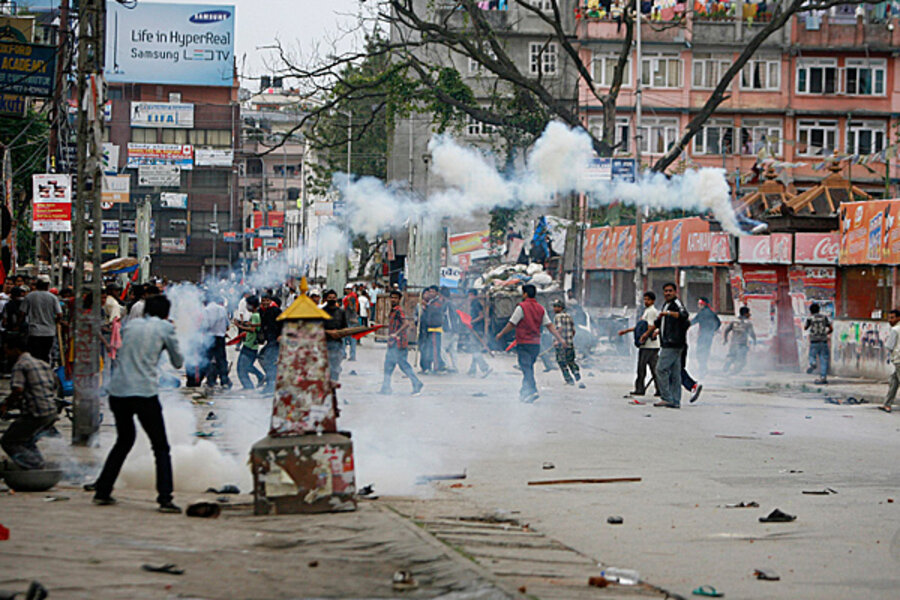Popular pressure spurs Nepal Maoists to end general strike
Loading...
| Kathmandu, Nepal
Nepal's Maoists ended a six-day general strike Friday amid pressures to ensure that the increasingly unpopular strike did not further undermine their standing among the general population.
Maoist chairman Pushpa Kamal Dahal, who goes by the name Prachanda, said in a press conference late Friday that Nepalese citizens should not be inconvenienced any further. He also said an end to the strike would deprive the government of opportunities to engineer clashes among Nepalese citizens.
“We have postponed the shutdown, but have not ended our other protests against this government,” he said.
But analysts said the Maoists' decision was forced by increasingly irate citizens. The strike disrupted food supplies and limited access to medical services. Clashes broke out in the capital with bused-in Maoist supporters. And Maoists came under fire for unleashing a conflict-era-style extortion campaign to feed the crowd, and commandeering private schools to shelter them.
By week's end, the upheaval appeared to have undermined any sympathy for the Maoists from the largely neutral citizens of Kathmandu, a group whose participation has been instrumental in all regime changes in Nepal’s history. Farmers and dairy owners were decrying the shutdown by throwing on the highways vegetable and milk that they could not take to the markets. On Friday, more than 10,000 people participated in a “peace gathering” in Kathmandu, and in Lalitpur district people overturned a truck carrying Maoist cadres and beat them up.
Ending the strike, some analysts say, may signal that Maoists are moving to adopt a more conciliatory approach that could change Nepal's troubled political landscape.
"The decision by the Maoists to ease the lives of ordinary citizens is a clear indication that they are feeling the heat," says columnist and lawyer Bhimarjun Acharya. “This is their response to the unpopularity of the shutdown and the consequent retaliation by locals against Maoist supporters."
“The Maoists made a mistake in trying to portray this shutdown as analogous to the nationwide protests in 2006,” Mr. Acharya adds, referring to the 19 days of nationwide protests in 2006 that forced King Gyanendra to relinquish executive authorities and kick-started the peace process. “Popular support comes from good agenda. This time the agenda is very personal."
Strike aimed to oust prime minister
The shutdown was meant to force Prime Minister Madhav Kumar Nepal to step down and allow Maoist chairman Prachanda to lead a new government. “The second unspoken agenda of the shutdown was to shift the blame for the Constituent Assembly’s incompetence on ruling parties,” says Acharya. The assembly, elected in 2008 as part of the peace process, has until May 28 to draw a new constitution.
But a power struggle since May last year, when Prachanda’s coalition government collapsed over the sacking of an Army chief, has hindered the assembly’s work, making it impossible for the assembly to meet that deadline.
Yubaraj Ghimire, former editor of Kathmandu Post daily, says the strike cost the Maoists more than just popular support. It also cost them the recognition as a political force they enjoyed since 2006.
“More than anyone, the shutdown affected the farmers and daily wage earners who the Maoists claim to represent,” Mr. Ghimire says. “A half-hearted response will not help Maoists regain the respect they have lost from the grassroots."
Before Friday evening, the Maoists appeared intent on prolonging the strike, as calling it off without some face-saving result would demoralize their supporters who have spent days on the streets beaten down by the sun and pre-monsoon drizzle in Kathmandu. In the press conference Friday evening, Prachanda said he would hold a mass gathering in Kathmandu on Saturday to explain his decision.
Low-key government stand
The government took a low-key approach to handling the shutdown, directing security personnel not to use lethal force and to intervene only to control clashes. The strategy appeared to be to wait for the protesters and their leaders to tire out.
With more than simple majority support in the parliament, the prime minister is constitutionally entitled to continue to head the coalition government.
But a prolonged shutdown could have tested the prime minister’s competence, says Narayan Wagle, editor of Nagarik daily, as his government’s inability to ensure that Nepalese citizens enjoy their rights to live normal lives could have turned the tide against him.
Related:





